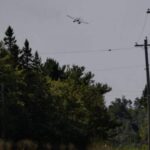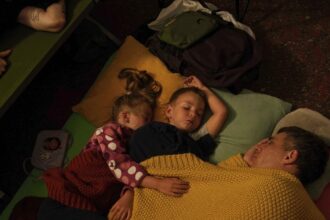The piercing wail of ambulance sirens cut through Gaza City on Saturday as rescue workers frantically sifted through the rubble of what was once a school serving as shelter for displaced Palestinians. Israeli airstrikes killed at least 36 people at the facility, part of a broader assault that claimed 52 lives across Gaza in a single day, according to Palestinian medical authorities.
The Al-Taba’een school in Gaza City’s Daraj neighborhood had become home to hundreds of families who had already been displaced multiple times during the nine-month conflict. Witnesses described scenes of horror as bombs struck the crowded facility without warning in the early morning hours.
“Children were sleeping beside their parents one moment, and buried under concrete the next,” said Mohammed Khalidi, a local doctor who assisted with rescue efforts. “We’re pulling bodies—many of them unrecognizable—from areas where families had sought what they believed was relative safety.”
The Israeli military claimed the school housed a Hamas command center, stating that “precision munitions” were used to target “confirmed terrorist operatives.” However, the Palestinian Health Ministry reported that most casualties were women and children, with dozens more injured in the attack.
This incident represents one of the deadliest strikes on a school-turned-shelter since the conflict began last October. The United Nations Relief and Works Agency (UNRWA) has repeatedly warned that no place in Gaza is safe, with over 150 of its facilities damaged or destroyed despite their protected status under international law.
“What we’re witnessing is the systematic destruction of civilian infrastructure,” said Sara Hamdan, a humanitarian coordinator who recently returned from the region. “Schools, hospitals, and shelters are being hit with devastating regularity, leaving Palestinians with nowhere to escape the violence.”
Beyond the school strike, Israeli forces conducted operations across multiple areas of Gaza on Saturday. In Rafah, where over a million Palestinians had sought refuge earlier in the conflict, five people were killed when missiles struck a residential building. Meanwhile, in central Gaza, eleven fatalities were reported after airstrikes hit market areas in Deir al-Balah.
The escalation comes as international mediators struggle to revive ceasefire talks that collapsed earlier this month. Diplomatic sources indicate negotiations have stalled over disagreements about post-war governance and the exchange of hostages and prisoners.
The humanitarian situation continues to deteriorate, with the World Food Programme reporting that famine conditions are expanding across northern Gaza. Medical facilities operate at minimal capacity, lacking essential medications and equipment while contending with overwhelming numbers of wounded.
“We’re treating complex injuries with virtually nothing,” explained Dr. Amira Nasser at Al-Aqsa Hospital. “Children with traumatic amputations, severe burns, and crush injuries are arriving hourly, but we lack even the most basic supplies to treat them properly.”
The conflict has now claimed over 38,000 Palestinian lives according to Gaza health authorities, with more than 87,000 wounded. Israel reports 1,200 deaths from the initial Hamas attack on October 7, with 116 hostages still held in Gaza.
As darkness fell over Gaza City Saturday night, rescue operations continued by flashlight at the bombed school, with families gathering to identify loved ones and collect what remained of their few possessions.
How many more civilian shelters must be destroyed before the international community moves beyond expressions of concern to meaningful action that protects innocent lives caught in this devastating conflict?
























